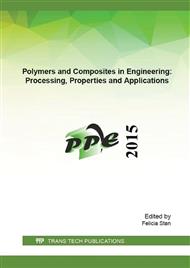[1]
R.E. Melchers, C.Q. Li, Reinforcement corrosion initiation and activation times in concrete structures exposed to severe marine environments, Cem. Concr. Res. 39 (2009) 1068-1076.
DOI: 10.1016/j.cemconres.2009.07.003
Google Scholar
[2]
C.G. Soares, Y. Garbatov, A. Zayed, G. Wang, Influence of environmental factors on corrosion of ship structures in marine atmosphere, Cor. Sci. 51 (2009) 2014-(2026).
DOI: 10.1016/j.corsci.2009.05.028
Google Scholar
[3]
C. Wei, J. Eliasson, E. Jansen, G. Wang, R.I. Basu, IMO PSPC Implementation And 15 Years of Target Useful Coating Life, NACE International.
Google Scholar
[4]
J. Hou, G. Zhu, J. Xu, H. Liu, Anticorrosion Performance of Epoxy Coatings Containing Small Amount of Inherently Conducting PEDOT/PSS on Hull Steel in Seawater, J. Mater. Sci. Technol. 29 (2013) 678-684.
DOI: 10.1016/j.jmst.2013.03.023
Google Scholar
[5]
R.E. Melchers, R.J. Jeffrey, Probabilistic models for steel corrosion loss and pitting of marine infrastructure, Reliab. Eng. Syst. Safe. 93 (2008) 423-432.
DOI: 10.1016/j.ress.2006.12.006
Google Scholar
[6]
M.T. Gudze , R.E. Melchers, Operational based corrosion analysis in naval ships, Corrosion Sci. 50 (2008) 3296-3307.
DOI: 10.1016/j.corsci.2008.08.048
Google Scholar
[7]
Recommended Practice DNV-RP-B101, (2007).
Google Scholar
[8]
P. Buskens, M. Wouters, C. Rentrop, Z. Vroon, A brief review of environmentally benign antifouling and foul-release coatings for marine applications, J. Coat Technol. Res. 10, (2013) 29-36.
DOI: 10.1007/s11998-012-9456-0
Google Scholar
[9]
Y. Yi, P. Cho, A. Al Zaabi, Y. Addad, C. Jang, Potentiodynamic polarization behavior of AISI type 316 stainless steel in NaCl solution, Cor. Sci. 74 (2013) 92-97.
DOI: 10.1016/j.corsci.2013.04.028
Google Scholar
[10]
E. Armelin, R. Oliver, F. Liesa, J.I. Iribarren, F. Estrany, C. Aleman, Marine paint formulations: Conducting polymers as anticorrosive additives, Prog. Org. Coat. 59 (2007) 46-52.
DOI: 10.1016/j.porgcoat.2007.01.013
Google Scholar
[11]
J. Hou, G. Zhu, J. Xu, H. Li, Anticorrosion Performance of Epoxy Coatings Containing Small Amount of Inherently Conducting PEDOT/PSS on Hull Steel in Seawater, J. Mater. Sci. Technol. 29 (2013) 678-684.
DOI: 10.1016/j.jmst.2013.03.023
Google Scholar
[12]
I. Gurrappa, G. Malakondaiah, Corrosion characteristics of DMR-1700 steel and comparison with different steels in marine environment, Mater. Sci. Eng. A 391 (2005) 235-242.
DOI: 10.1016/j.msea.2004.08.079
Google Scholar
[13]
R.E. Melchers, A new interpretation of the corrosion loss processes for weathering steels in marine atmospheres, Cor. Sci. 50 (2008) 3446-3454.
DOI: 10.1016/j.corsci.2008.09.003
Google Scholar
[14]
K. Al-Muhanna, K. Habib, Corrosion behavior of different alloys exposed to continuous flowing seawater by electrochemical impedance spectroscopy (EIS), Desal. 250 (2010) 404-407.
DOI: 10.1016/j.desal.2009.09.065
Google Scholar
[15]
H. Wall, L. Wadsö, Corrosion rate measurements in steel sheet pile walls in a marine environment, Marine Struct. 33 (2013) 21-32.
DOI: 10.1016/j.marstruc.2013.04.006
Google Scholar
[16]
H. Katayama, S. Kuroda, Long-term atmospheric corrosion properties of thermally sprayed Zn, Al and Zn–Al coatings exposed in a coastal area, Cor. Sci. 76 (2013) 35-41.
DOI: 10.1016/j.corsci.2013.05.021
Google Scholar
[17]
S.S. Xin, M.C. Li, Electrochemical corrosion characteristics of type 316L stainless steel in hot concentrated seawater, Cor. Sci. 81 (2014) 96-101.
DOI: 10.1016/j.corsci.2013.12.004
Google Scholar
[18]
K. Wang, J. Unger, J.D. Torrey, B.D. Flinn, R. K. Bordia, Corrosion resistant polymer derived ceramic composite environmental barrier coatings, J. Eur. Ceram. Soc. 34 (2014) 3597-3606.
DOI: 10.1016/j.jeurceramsoc.2014.05.036
Google Scholar


